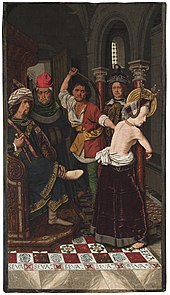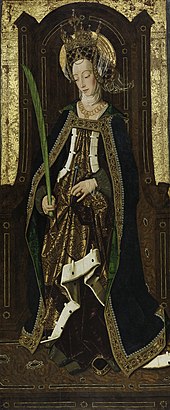Engratia of Zaragoza

Engratia von Saragossa ( Spanish Santa Engracia ; French Sainte-Engrâce ; * around 280 in Braga , Portugal , † 303 in Saragossa , Spain ) was an early Christian martyr who was later revered as a saint and who lost her life during the Diocletian persecution of Christians . It is mainly venerated on the Iberian Peninsula and in France ; her feast day is April 16.
Vita
The noble parents of Engratia wanted to marry their daughter to a man of high standing; on the wedding procession, Engratia and her companions stopped in Caesaraugusta, today's Saragossa. Here they learned about the persecution of Christians under the leadership of the governor Dacian . She dared to approach him and asked him to stop the persecution; she and her companions were then thrown in prison and tortured. At the end a glowing nail was stuck in her head; their companions were beheaded. Her body and the remains of her entourage were interred in a small cemetery south of the city. The Basilica of St. Engratia was later built here .
Another version of her legend tells that she survived the torture and reached old age.
Adoration
The late antique poet Prudentius (around 348-405) wrote a hymn (peristephanon) in her honor . At a synod in 592 it was decided to venerate all the martyrs of Saragossa together on November 3rd. In a 7th century chronicle, their number grew to 18,000. In the following years several churches were consecrated, including the Igreja de Santa Engrácia in Lisbon ; some places are also named after her.
presentation
High medieval representations of the saints are not known. Some late medieval and early modern paintings as well as later Baroque statues show them in a noble robe (sometimes with a martyr's palm or a book).
literature
- Juan de la Concepción: Vida de la gloriosa Santa Engracia virgen y martir y de los diez y ocho martires de Zaragoça. 1677.
Web links
| personal data | |
|---|---|
| SURNAME | Engratia of Zaragoza |
| BRIEF DESCRIPTION | early Christian martyr |
| DATE OF BIRTH | 3rd century |
| PLACE OF BIRTH | Braga |
| DATE OF DEATH | 303 |
| Place of death | Zaragoza |
